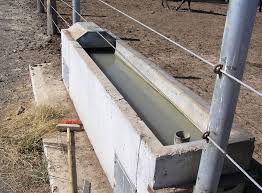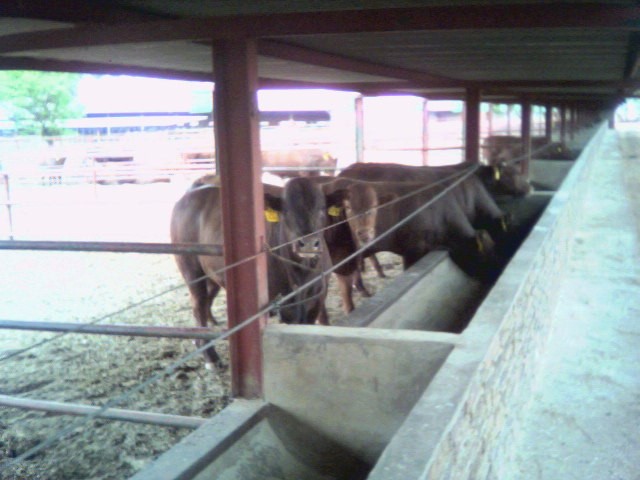Water Troughs
The amount of trough space available when providing watering facilities or feeding livestock significantly influences the performance of livestock. Drinking troughs warrant special attention because an excessive amount of water is wasted when troughs are cleaned regularly, as is necessary for good management. Furthermore, poor design results in animals falling into troughs and drowning. It is not uncommon for cattle to fall onto their backs in a trough and die if they cannot get up. Water trough design must take the following into consideration:
- Water troughs must be easy to clean.
- A straight trough is easier to clean than a round or circular trough because a broom can be pushed through it with ease.
- A drain plug that is tamper-proof is needed to allow easy drainage.
- The water inlet must include a tap so that the water supply can be turned off to drain the trough. Siting the tap well away from the trough prevents damage to the tap.
- The ideal width is about 20 cm. This allows animals to drink with ease and minimizes the danger of animals falling into the trough.
- Where the sides of the trough are broad, as with concrete troughs, the edge of the trough must slope towards the water. This discourages animals from placing their hooves into the trough.
- The height of the trough above the surrounding ground should be 20 to 40 cm, with the water level in the trough not more than 10 cm deep.
- The trough should be anchored to the ground to prevent animals from knocking it over.
- Pipes to and from the water trough must be protected to prevent animals from hurting themselves, as well as to prevent damage to the pipes.
- The water supply and delivery pipes to the drinking water should be large enough to ensure that animals do not drain the trough when they drink. Once a water trough is empty, animals start bumping it in their impatience to get water.

Feed and Lick Troughs
A feed bunker is a trough or bunker in which the feed is placed for the animals to feed on. Good feed bunk design is essential to optimising DM (Dry Matter) intake. Cattle should have 60 to 75 cm of bunk space each to allow all of them to feed at the same time. The feed bunk or feed pad should be 10 to 15 cm higher than the alley where the cattle are standing. Cattle consuming feed at ground level waste less feed.
In addition, the condition of the feeding surface can also affect DM intake. Feed bunks must have smooth surfaces. Surfaces without grooves or holes that can trap feed are easier to clean and help reduce the build-up of waste feed, mould growth and odour.
Another important factor is to avoid muddy conditions and manure build-up on feed bunk aprons. These conditions can decrease the palatability of the ration as well as increase the transmission of disease.
Feed and lick troughs can be made from almost any material. Inverted rubber tyres have become very popular because they do not rust and cannot cause injury to animals, are cheap and readily available.
Prior to the start of feeding, animals must be grouped according to the size of the animal and age group. By dividing livestock into production groups, feeding is simplified because each group can be fed a ratio suited to its requirements. Separating animals into groups overcomes the problem of larger animals dominating at feed troughs and preventing smaller animals from obtaining their allocation of feed. Especially where feed is rationed, adequate trough space is essential to prevent smaller animals from losing mass and condition, while larger animals get over fat.
Where trough space is limited, cattle can cause damage to troughs or turn them over when they butt each other in an effort to reach the food. Damage to troughs and the loss of food is reduced if troughs are firmly anchored to the ground.

Feed- and water through space requirements for different classes of livestock.
|
Class of livestock |
Trough space required per animal (mm/animal) |
|
|
Feed |
Water |
|
|
CATTLE |
. |
. |
|
SHEEP |
. |
. |
|
PIGS |
. |
|
|
POULTRY |
. |
|
Click here to view a video that explains livestock environmental protection.